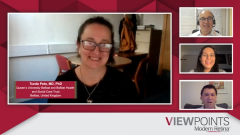
Diabetic Macular Edema: Treatment Overview
A discussion regarding the roles of various treatments available for diabetic macular edema and considerations for selecting and sequencing therapy.
Episodes in this series

Albert J. Augustin, MD: When we come to the management of diabetic macular edema, the treatment options are much more diverse. Dr. Korobelnik, could you focus a little bit on anti-VEGF [vascular endothelial growth factor] therapy, steroids, implants, and combination therapy? Perhaps you could also address your opinion concerning micropulse laser treatment? Possibly as a monotherapy and in combination setting?
Jean-Franҫois Korobelnik, MD: I truly agree with that. For DME [diabetic macular edema], we have more options than for wet AMD [age-related macular degeneration]. Of course, we use the same VEGF inhibitors as we used in AMD. As Tunde said, we use them based on local regulation and how the drugs are covered. However, for DME we can use steroids; maybe not as a first-line treatment, it can be in some cases, but it’s definitely something that is to be considered in DME patients. As you said, we have laser treatment. Micropulse is something that is interesting, but we miss some truly demonstrative studies to be sure that it is effective. Now we also have targeted photocoagulation in [INAUDIBLE] that has been abandoned since VEGF inhibitors came. It is now able to be done precisely based on the fundus photo of the fluorescein or late ICG [indocyanine green angiography]. For DME, we definitely have the choice. Each one has to consider whether they want to do first. However, most often the first choice is VEGF inhibitors. Many patients are responding. However, depending on the patients’ response and the capacity of the patients being able to attend appointments, we may select other options. Of course, do not forget to look for, check, and control glycemia to control blood pressure. Those systemic parameters are extremely important for DME. We see some patients when their blood pressure is well controlled, their glycemia is well controlled, and things get much better.
Tunde Peto, MD, PhD: Can I add something to that before you ask your next question? There might be some listeners who are from countries where anti-VEGF agents are not widely available, or people need to buy them and they can’t afford them. You always should do a clinical examination and try to figure out if laser, if you have, might be useful. Some patients will be helped by laser treatment initially. If that is the case, then it’s important it is done. Additionally, laser treatment has been used in a lot of anti-VEGF and steroid trials. Sometimes it is possible to treat; to give an additional laser treatment and make sure those patients who might not be able to afford more treatment injections are able to get some benefit from that treatment as well.
Jean-Franҫois Korobelnik, MD: I fully agree Tunde. One very important thing to consider in diabetic patients is not to focus only on the macula but look at the periphery. You can have diabetic retinopathy, lung perfusion, and, in some cases, proliferation of new vessels. We do see from time to time in some patients that are being treated for DME, and they have proliferative disease that was underdiagnosed. You must evaluate the periphery in those patients.
Tunde Peto, MD, PhD: This is becoming a real issue during COVID-19 when people did not get their injections. Suddenly, they come back with bad diabetic eye disease, with rubeotic glaucoma, because it was the injection that kept it at bay. Good examination and laser treatment would be very helpful for a lot of patients still.
Albert J. Augustin, MD: Anyhow, our focus for today is diabetic macular edema. I fully agree that we must look for those people as well, and we must look for systemic control and retinal periphery.
Transcript edited for clarity.
Newsletter
Keep your retina practice on the forefront—subscribe for expert analysis and emerging trends in retinal disease management.









